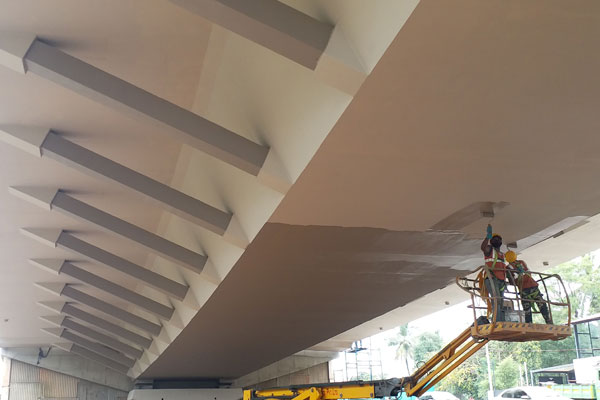Carbonation in reinforced concrete is one of the most common forms of deterioration in structures. It is the reaction of carbon dioxide from the environment with the calcium hydroxide in the cement paste. Due to carbonation, the protective oxide layer surrounding the structure’s reinforcing steel breaks down and corrosion or rusting starts. Deterioration is much faster in structures such as bridges which are associated with the ingress of water and freeze/thaw cycling. Carbon dioxide from the atmosphere reacts with the concrete in these structures, leading to a loss of alkalinity and subsequent corrosion of the reinforcing steel. Once the concrete is rusting, concrete starts to stall and falls off leaving an open passage for contaminants to easily penetrate the concrete. The structural integrity of bridges can be compromised until it is protected with an anti-carbonation protective coating.
Anti-carbonation protective coatings protect bridges against the ingress of carbon dioxide and water, and additionally chlorides and sulphates as well whilst allowing damp substrates to breathe without blistering. They protect concrete from the carbonation and also from chlorides and sulphate induced corrosion by acting as a barrier against these pollutants along with water.
MC-Bauchemie is one of the specialist manufacturers and suppliers of anti-carbonation coating products in INDIA. In this article, we have focused on a project wherein their anti-carbonation protective products were used to meet the subsequent carbonation challenges in a bridge. ATAL SETU Project [which was earlier known as Mandovi Bridge], in Goa, INDIA is the project in focus. The surface protection work of the bridge was executed by using a range of MC-Bauchemie India’s anti-carbonation protective coating products.
What anti-carbonation products were used for the protection of the bridge?
Application of MC-Bauchemie India Anti Carbonation Protective Coatings used Atal Setu
Structure Requirement;
The first Cable-Stayed Bridge by L&T in India situated in Goa over Mandovi river later named Atal Setu had a requirement of 1.5 lac m2 of surface area to be protected from environmental deterioration.
Anti-carbonation coating products used in the project;
Anti-carbonation coatings were used for surface treatments that have a high resistance to carbon dioxide. The products safeguarded the bridge structure from carbonation by acting as a carbon dioxide barrier. The range of products used were EmceColor®-flex, Nafuquick® and Primex 250.

EmceColor®-flex
EmceColor®-flex is an acrylic polymer modified elastic elastomeric breathable, anti-Carbonation coating product. 70 tons of the product was used for the project. The primary reason for the selection of the product is that it has crack bridging and UV-resistant protective features that shields against environmental degradation. It is also water-based and solvent-free. It provides excellent protection for concrete structures such as bridges subjected to adverse climatic conditions.
The product is waterproof and has a low water vapour diffusion coefficient. This makes the coating breathable. It also has a high resistance to diffusion of carbon dioxide and thus has good anti-carbonation properties. In addition, EmceColor®-flex is crack bridging, which is advantageous in case of repair and protection of cracked facades, exhibiting hairline and shrinkage cracks.
Nafuquick®
It is a polymer-modified filler that provides a single layer of up to 6 mm. The product is ready to use, you just need to mix it with water. It is colourfast and offers light-resistant pigmentation.
Primex 250
It is an acrylic primer that rapidly dries and improves adhesion. It reduces absorbency, binds dust and is solvent-free.
Many benefits were obtained by incorporating the anti-carbonation coatings for the project in a well-designed manner. These include prevention of water ingress and chemicals and de-icing salts from penetrating the structural deck of the bridge thereby preventing the steel reinforcing bars from corroding.
MC- Bauchemie India’s anti-carbonation products
The right selection of anti-carbonation products is pivotal for bridge structures. The anti-carbonation product lines of MC- Bauchemie India offer ultra-modern surface coating solutions relating to the protection and colouring of concrete surfaces. The pure, pro and vision variants are available within each product line. The construction chemical applicators are sure to find a tailored solution to their specific requirements. All the products are water-repellent, open to vapour diffusion, carbonation-retarding and resistant to UV, soiling and weathering.
MC-Bauchemie (India) Private Limited
B-501, Shelton Sapphire, Sec 15, CBD Belapur, Navi Mumbai – 400614
Phone +91 22 2757 0803
Email: info.india@mc-bauchemie.com
For more details on anti-carbonation products, visit- https://www.mc-bauchemie.in/products/surface-protection/#/category-products

